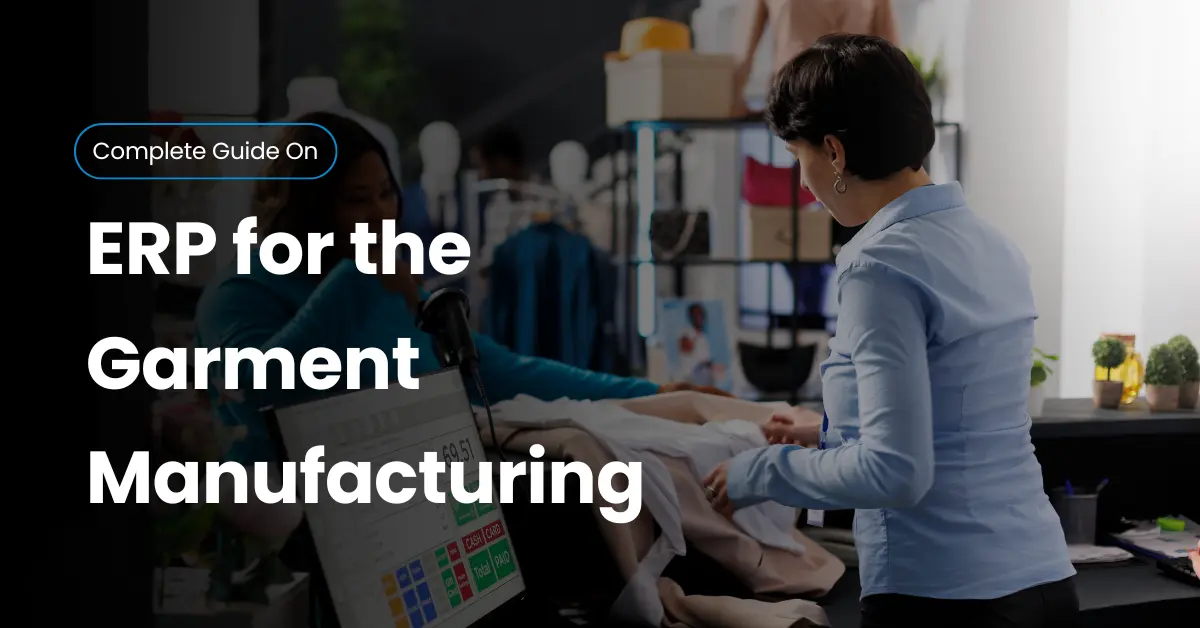Running a garment business today is no small feat. Between demand forecasting in garment manufacturing, global competition, and razor-thin margins, even small mistakes can cut deep into profits. That’s why more apparel businesses are turning to ERP for the Garment Manufacturing Industry—a complete system to streamline operations and boost growth.
Think of it as your control center. From raw fabric sourcing to design-to-delivery ERP workflows, every department gets real-time visibility. With solutions like Infintrix ERP, you don’t just manage your factory—you run it smarter, faster, and with far less waste.
Table of Contents
- Introduction
- Understanding ERP in Garment Manufacturing
- Key Benefits of ERP for the Garment Industry
- Core Features Tailored for Apparel Manufacturers
- Real-Time Data: The Heart of Modern ERP
- Driving Profitability Through ERP Adoption
- Conclusion
- FAQ
Understanding ERP in Garment Manufacturing
What ERP means for fashion and apparel businesses
At its core, ERP for garment industry means integrating all critical processes—design, production, supply chain, and sales—into one unified platform. Instead of juggling spreadsheets or disconnected software, a modern apparel ERP solution brings everything together for speed, accuracy, and clarity.
Difference between generic ERP and industry-specific solutions such as Infintrix ERP
Generic ERP can handle accounting and inventory, but it often struggles with the complexity of garment production software. By contrast, textile ERP software like Infintrix is tailored to track styles, sizes, and color variations. That level of detail makes it ideal for the fashion industry ERP environment.
Quick takeaway: If you’re in apparel, go for an industry-specific ERP—it saves time, prevents errors, and adapts better to fashion cycles.
Key Benefits of ERP for the Garment Industry
Streamlining design-to-delivery workflows
ERP in apparel merchandising ensures designs move smoothly into production without data silos. This means your CAD designs, fabric needs, and production timelines connect seamlessly. With garment production software, bottlenecks vanish and delivery deadlines are easier to hit.
Improving demand forecasting and inventory balance
Forecasting demand is tough when fashion trends change overnight. That said, ERP for fashion trend forecasting uses historical sales and AI-driven insights to strike the right balance. No more overstocking slow-moving items or running out of bestsellers.
Example: A clothing brand used ERP to cut overstock by 25% while still meeting customer demand on time.
Enhancing communication across departments with tools like Infintrix ERP
Lack of communication is one of the biggest pain points in apparel factories. ERP for apparel industry solves this by giving all teams—designers, production managers, and warehouse staff—real-time updates. When everyone sees the same dashboard, costly errors drop dramatically.
Benefits of cross-department ERP visibility:
- Fewer production delays
- Better alignment between sales and manufacturing
- Faster approvals and product launches
Core Features for Apparel Manufacturers
Demand Forecasting & Planning
Demand forecasting in the garment industry is tricky, but Infintrix ERP leverages AI to predict trends and customer preferences. By using ERP modules for garment industry planning, manufacturers stay ahead of seasonal shifts and improve sell-through rates.
Materials Requirements Planning (MRP)
Running out of fabric mid-production is a nightmare. ERP for apparel industry automates fabric and trim procurement with materials requirements planning (MRP). This means every purchase order matches actual production needs, cutting delays and last-minute supplier headaches.
Tip: Integrating MRP ensures suppliers deliver just the right amount—no excess inventory, no shortages.
Advanced Inventory Management
Unlike basic inventory tools, garment production software tracks stock by sizes, styles, and colors in real time. That’s critical when a bestseller runs out in one size but sits idle in another. With textile ERP software, managers see these gaps instantly and can restock smartly.
Vendor & Supplier Management
Suppliers are the backbone of apparel production, but managing them manually often causes miscommunication. ERP for garment industry includes vendor portals where manufacturers and suppliers collaborate in real time. Infintrix ERP ensures transparent pricing, faster approvals, and fewer disputes.
Vendor portal advantages:
- Track supplier performance
- Centralize communication
- Streamline approvals and payments
Warehouse & Logistics Integration
Fast delivery is non-negotiable in today’s fashion industry ERP world. With ERP, warehouse operations connect directly to logistics partners. This cuts down errors in order fulfillment and keeps global deliveries smooth. For export-oriented factories, ERP for the RMG sector ensures compliance with international shipping requirements.
Real-Time Data: The Heart of Modern ERP
Faster, more confident decision-making
Garment businesses can’t afford to wait for monthly reports. With real-time ERP for fashion, managers spot problems immediately and act fast. Whether it’s halting a line with defects or reallocating inventory, decisions happen in minutes—not weeks.
Agility in responding to market trends
ERP for fashion supply chain gives brands the agility to pivot production when a new trend emerges. Instead of getting stuck with outdated stock, businesses adapt quickly. That’s a game-changer in fast fashion where being late by even one season can mean huge losses.
Example: Infintrix ERP’s real-time dashboards
Imagine logging in and instantly seeing today’s production status, open orders, and inventory levels—all on one dashboard. That’s what Infintrix ERP delivers. These real-time insights help apparel businesses stay lean, responsive, and competitive in a demanding industry.
Driving Profitability Through ERP Adoption
Reducing waste and overhead costs
Fabric waste, rework, and overproduction eat into margins. With ERP for garment manufacturing, companies track resources in real time and reduce unnecessary costs. Smarter apparel production planning means fewer errors and more profits.
Quick stat: Brands using ERP cut waste by up to 20%, boosting both efficiency and bottom line.
Supporting sustainability and ethical sourcing
Sustainability isn’t just a buzzword anymore—it’s a customer expectation. ERP for sustainable fashion manufacturing helps brands trace materials back to ethical sources, monitor compliance, and reduce environmental impact. With Infintrix ERP, businesses prove responsibility while staying profitable.
Key benefits of sustainability with ERP:
- Better supplier transparency
- Accurate compliance tracking
- Lower carbon footprint
Boosting customer satisfaction and repeat sales
At the end of the day, happy customers fuel growth. ERP-driven customer satisfaction in fashion comes from timely deliveries, accurate orders, and consistent quality. Infintrix ERP helps brands build loyalty, which means more repeat sales and stronger word-of-mouth referrals.
Conclusion
Adopting ERP for the Garment Manufacturing Industry isn’t just about cutting costs—it’s about future-proofing your business. From demand forecasting to real-time analytics, ERP creates a stronger, more resilient foundation for growth.
With tools like Infintrix ERP, garment manufacturers can scale smoothly, adapt to fashion’s fast pace, and remain profitable in a highly competitive global market. Simply put, ERP isn’t an expense—it’s an investment in long-term success.
FAQ
How does ERP help reduce costs in garment manufacturing?
ERP lowers costs by automating production planning, minimizing fabric waste, and optimizing supply chains. With cost control in ERP systems, companies see real-time spending and can cut expenses where it matters most.
Is Infintrix ERP suitable for small and medium garment enterprises (SMEs)?
Yes, absolutely. Infintrix ERP for small and medium garment enterprises (SMEs) scales as you grow. It’s flexible enough for startups yet powerful enough for global apparel brands.
Can ERP adapt to fast fashion trends?
Definitely. ERP for fashion trend forecasting uses AI and analytics to help manufacturers pivot quickly. This agility ensures they stay ahead of competitors while meeting customer expectations on time.

